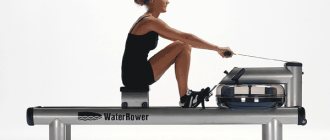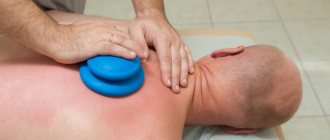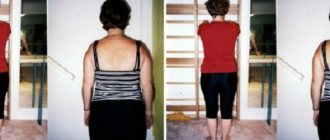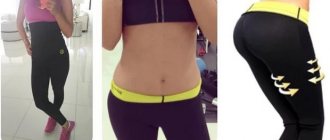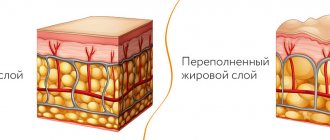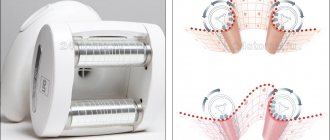Liposuction (translated as “fat suction”) is one of the most effective medical techniques for eliminating local fat deposits and cellulite. There are different types of this procedure, the most optimal and gentle of which is considered to be laser liposuction.
Laser liposuction is a non-surgical method of body contouring that allows you not only to say goodbye to unnecessary fat in problem areas, but also to model new volumes of your body.
Laser liposuction helps you achieve a slim body without exhausting diets and grueling exercise.
1
Laser liposuction
2 Laser liposuction
3 QuadroStar Lipo device
The need for laser lipolysis
The main reason why patients choose this procedure is the opportunity to get rid of cellulite, as well as remove fat deposits on the face and chin. Already after the first procedure, the number of fat cells in the treatment areas will be noticeably reduced (approximately 25-30% of the required).
This method allows you to remove the volume of adipose tissue, but not weight (therefore, it is not suitable for solving the problem of obesity). The process of drying the subcutaneous layers suppresses the hyperfunction of the sebaceous and sweat glands - due to this, the effect is visible immediately after the procedure, each subsequent session also improves the result.
Main advantages of the procedure:
- As previously mentioned - quick and visible effect after the first procedure
- Without loss of ability to work - quick rehabilitation period
- Low trauma and painlessness
- Lipids are destroyed and eliminated from the body naturally
- Suitable for all age groups
- Laser ensures complete disinfection
As a rule, after a course of procedures, patients notice the effect of rejuvenation and improvement of the figure as a whole (if the body was treated).
Why are radiofrequency lipolysis and lifting so effective?
The essence of the RF lifting technique is to influence the skin and its elastocollagen framework, as well as subcutaneous fat tissue, with radio waves in three different precisely defined ranges.
Three waves of different frequencies ensure penetration of RF energy to different depths and have a tonic effect on fatty tissues and skin. As a result of radio wave exposure, fat cells are broken down, resulting in a reduction in volume. In addition, radio waves affect the collagen and elastin fibers of the skin, starting the process of their renewal and stimulating the production of the so-called 3-dimensionally oriented neocollagen, which ensures the elasticity of young skin.
Burning fats in the process of lipolysis - features and description of the process
The lipolysis process is accompanied by natural metabolism , which is responsible for the breakdown of lipids into triglycerides, fatty acids and glycerol. The next stage is the inclusion of these components in enzyme complexes, as well as the formation of a protective subcutaneous layer with the construction of cell membranes.
You should not use painful diets for the purpose of losing weight, because the process of burning fat involves energy consumption, which cannot be accomplished without proper nutrition. Most nutritionists are against fasting and suggest a balanced diet (which ensures natural biochemical synthesis in the body).
Neuroendocrine regulation is an important component of the process of natural lipid transformation. The effect of lipolysis is often enhanced under stress
How is the RF lipolysis and body lifting procedure performed?
To carry out RF lipolysis, a special F-Contour applicator is used, which ensures the penetration of radio frequency energy to various depths of subcutaneous fat and ensures gradual heating of tissues and lipolysis of fat cells. To achieve a powerful body skin lifting effect, another applicator is used - SkinTightening, and for delicate areas (neck, décolleté and the inner surface of the arms and shoulders) more delicate modes and the B-Contour applicator are used.
Thanks to the gradual deep heating of the tissues, there is no pain. After the procedure, “deep heat” remains for several hours, prolonging the lipolysis process started during the procedure.
The ReAction procedure is painless and completely non-traumatic. After applying a special gel to the skin, the cosmetologist treats problem areas with RF pulses along certain lines. During the procedure, several modes are used to deliver waves to different depths; the intensity of the impact is selected individually by the cosmetologist and is strictly controlled automatically.
The procedure lasts from 30 minutes to 90 minutes, depending on the goals and area of the body being treated.
Need a consultation?
How long does the effect of the procedure last?
It is impossible to remove all fat forever, but you can significantly reduce its amount. If the patient adheres to proper nutrition and leads an active lifestyle (playing sports), then the results of laser lipolysis will last for a long time. Laser lipolysis will remove existing fat, but does not prevent the appearance of new fat deposits.
Fat begins to be deposited if a person leads a passive lifestyle, eats poorly, has some kind of disease, or is often exposed to stress.
Indications for the ReAction procedure
Thermolifting procedures using the ReAction device can significantly tighten even not young and sagging skin. In addition to patients seeking to maintain youth, get rid of cellulite and improve the silhouette of their body, the procedure is recommended during the rehabilitation period after all types of surgical liposuction to prevent fibrosis and sagging skin.
The capabilities of the new Israeli device ReAction are not limited to lipolysis and body tightening; it is no less effectively used for non-surgical lifting and facial rejuvenation.
Cosmetologists at the DoctorPlastic clinic will be happy to tell you about the new possibilities of this and other technologies for non-surgical body correction. If necessary, we will invite a plastic surgeon to your consultation to discuss all the possibilities and together find the most effective but gentle solution to your problems
Laser lipolysis technique - stages of the procedure
Examination by a doctor and initial consultation are the first stage of the procedure. Next, based on the received recommendation, an individual course and its duration are drawn up. The specialist will determine the required areas of laser exposure and its intensity.
Tests may be taken to determine the need for the procedure. As a rule, this is affected by the density and volume of fat deposits.
After the preparation stage, the procedure itself begins, which consists of the following steps:
- Laser treatment areas are marked with a special marker. This is necessary so that the doctor treats only the necessary areas, without affecting other areas of the body.
- Those areas of the skin that will be subject to laser treatment are pre-cleaned and local anesthesia is administered. The most common solution for numbing these areas is a lidocaine gel (or solution). The effect is achieved 20-25 minutes after applying the product to areas of the body.
- Next, the doctor provides piercing in the required places using special needles. A tube with a cannula is inserted into these punctures, through which a laser beam penetrates inside.
- Next, the equipment is configured taking into account the individual characteristics of the patient’s body. The laser immediately begins to act on fat deposits and destroys them
- After the procedure, the treated areas are disinfected and the pads are removed. Temporary redness may occur, so doctors apply soothing agents.
Is it possible to supplement laser lipolysis with other procedures?
Laser lipolysis is recommended to be combined with procedures that accelerate the flow of lymph and promote the rapid removal of residual fat cells.
Work well in combination with a laser:
- myostimulation or electrolipolysis - the effect of electric current pulses on muscle fibers;
- RF lipolysis is a method based on the use of radio waves;
- vacuum massage;
- mesotherapy – injection of a cocktail of vitamins and enzymes;
- Pressotherapy is the application of pressure to certain areas of the body in order to accelerate the flow of lymph.
The combination of procedures speeds up obtaining the desired result.
Indications and contraindications
Correction of the figure and elimination of imperfections is the main indication for the laser lipolysis procedure. The fight against cellulite, excess fat, sagging skin, stretch marks and stretch marks - all this also applies to indications. Laser lipolysis also allows you to get rid of a double chin and adjust this area according to the patient’s preferences.
The procedure is completely safe, but there are a number of contraindications that cannot be ignored (check with your doctor for more details):
- Acute infectious diseases (including skin infection)
- Diabetes, HIV and herpes
- Oncological diseases
- Phlebitis, thrombophlebitis, varicose veins and other vascular diseases
- Diseases of the cardiovascular system
- Diseases of the stomach and pancreas (including liver)
- High body temperature
- Presence of implants, pacemakers and prostheses
- During pregnancy
These are the main contraindications that you should pay attention to.
Contraindications
- diabetes;
- oncology;
- chronic diseases of the heart, lungs, kidneys, liver;
- blood clotting disorder;
- infections, viral diseases;
- fever;
- skin diseases;
- epilepsy;
- autoimmune diseases;
- damage to the skin;
- presence of implants, prostheses, pacemaker (in the area of the procedure);
- pregnancy, breastfeeding.
At a preliminary consultation, the doctor will determine your health status. If necessary, laboratory tests may be prescribed. Contraindications to Photon lipolysis are not just recommendations - it is a matter of your safety.
Laser-induced natural lipolysis process
This process naturally “decays” the adipocyte without killing the cell.
For wavelengths in the visible range (530–660 nm), where the depth of penetration and maximum absorption occurs in the layers of the dermis, the launch of the lipolytic effect is a side, indirect one. This process occurs through the activation of lymphatic circulation, the response of local immunity with the launch of the adrenaline-glucagon hormonal reaction. This path is slower. The procedures take about 60 minutes, the result of one procedure is insignificant (1–1.5 cm). For infrared wavelengths, there is a spectrum range with a particularly selective effect on fat. This range is 980–1064 with a peak at 1060 nm.
The wavelength of 1060 nm is well absorbed by fat cells and has a predominant chromophore of triglycerides (fat). It is able to penetrate to the required depth for an effective effect on adipocytes, while being extremely weakly absorbed by the dermis. This wavelength has minimal impact on melanin, so it is suitable for all phototypes, even tanned skin. The energy created by the laser, actively absorbed by the structures of biological tissues, is transformed into thermal energy, causing an increase in the permeability of adipocyte membranes. To create conditions for the greatest impact effect, it is necessary to maintain a local temperature of 42–45 ° C, the recommended exposure time is 25 minutes.
Video SLIMUS: laser vibration lipolysis for correction of body contours
As described above, a wavelength of 1060 nm correctly and efficiently affects subcutaneous adipose tissue. Due to this, no unwanted side effects are observed in the dermis of the treated area. Considering that the contents of adipocytes are released and naturally processed by the body, lipid metabolism indicators could be of concern. However, clinical studies have not demonstrated significant changes in serum lipid or biochemical composition after the SLIMUS laser lipolysis procedure. The transcutaneous lipolysis procedure using a 1060 nm diode laser is very well tolerated. The most common side effects include minimal discomfort during the procedure and some tenderness in the area after the procedure. To achieve long-lasting, optimal results, patients may undergo multiple lipolysis treatments spaced four weeks or more apart. Clinical studies have demonstrated positive results when creating customized treatment protocols consisting of three or fewer lipolysis treatments on the flanks and/or abdomen. Among other things, under the influence of the Slimus laser, the dermal matrix is normalized with the restoration of collagen and elastin fibers with the restoration of the volume of hyaluronic acid. The skin in the treatment area is tightened, turgor is normalized, and the appearance of cellulite is eliminated.
